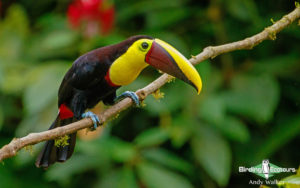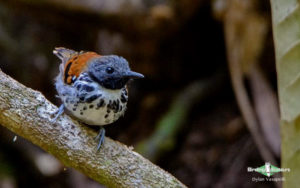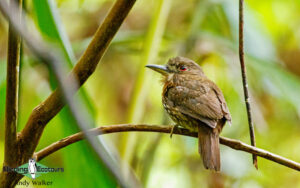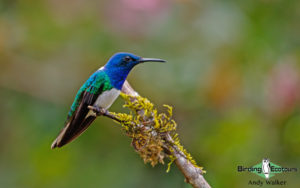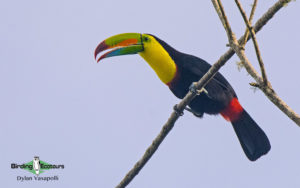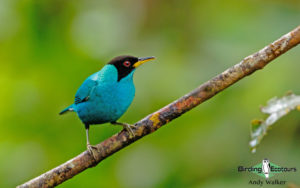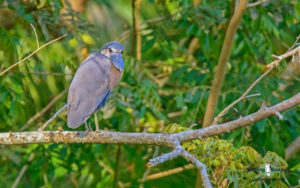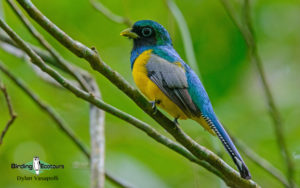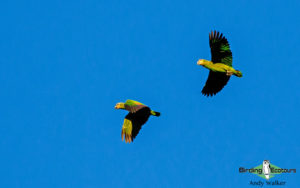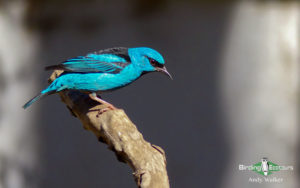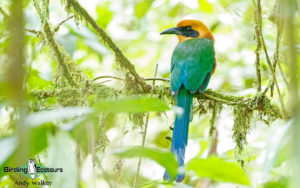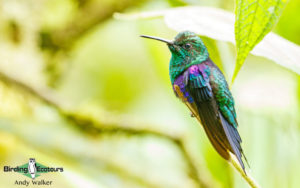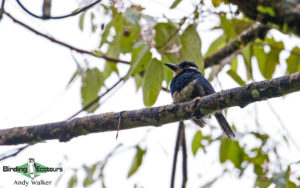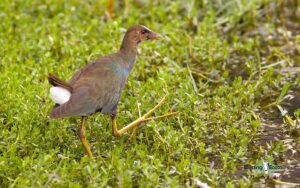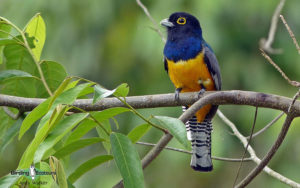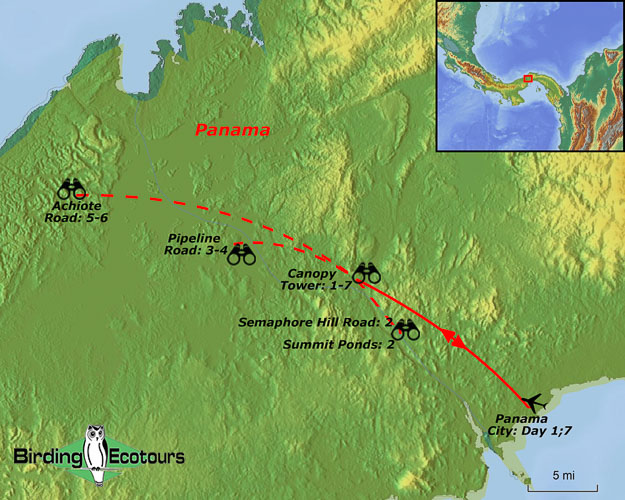Panama Escape: An easy week of birding from the Canopy Tower Lodge
Go to: Panama Birding Tours | Birding Tours in the Neotropics | All our birding tours
Panama Escape: an easy week of birding from the Canopy Tower Lodge
December 2025
Our exciting 7-day trip to Panama is designed to explore one of the greatest birding hotspots in Central America, the famous Canopy Tower Lodge, where we will be based for the entire trip. This tour serves as a perfect introduction to neotropical birding, particularly for those who have never set foot in this magical part of the world. Our tour includes early starts (which you can opt out of if preferred) and full mornings for each day but we ensure the afternoons’ activities are kept flexible, allowing for exploration of the lodge surroundings at your own leisure. Guests can use this time to search for more bird species, enjoy the lodge and observation deck, or as an opportunity for some personal photography at an easier pace. We invite you to discover Panama, spending the entire week in one fantastic destination (without the stress of overland travel across the country), and to enjoy our short, relaxed birding vacation.
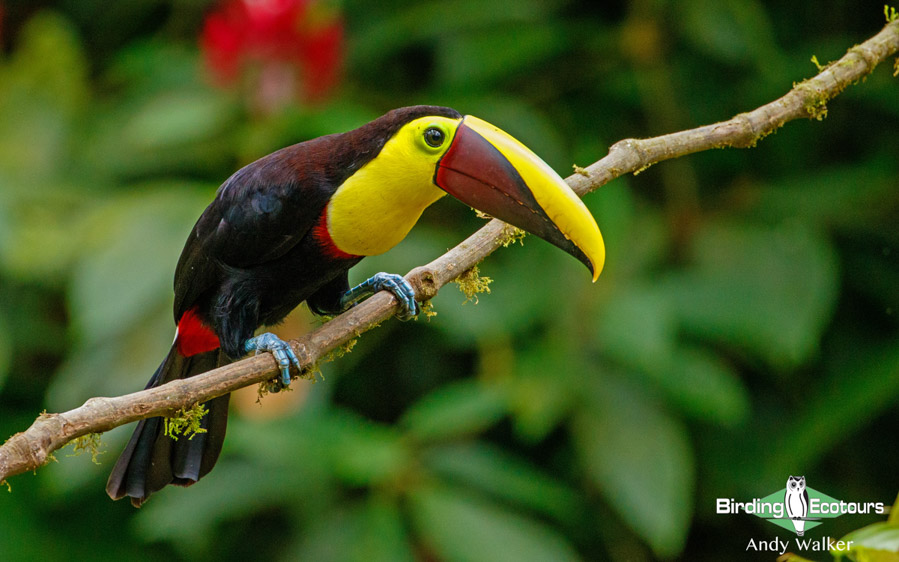
Our tour focuses exclusively on exploring the surroundings of the Canopy Tower, including the popular Pipeline, Achiote, and Semaphore Hill Roads, the Rainforest Discovery Center Tower, and the Summit Ponds near the Gamboa Wetlands. Each day we will have the chance to enjoy the magnificent forest views from the impressive Canopy Tower observation deck. Being 50 feet (15 meters) above the ground, the deck provides a unique eye-level view of the canopy forest and canopy-dwelling bird species, all while enjoying our morning cup of coffee.
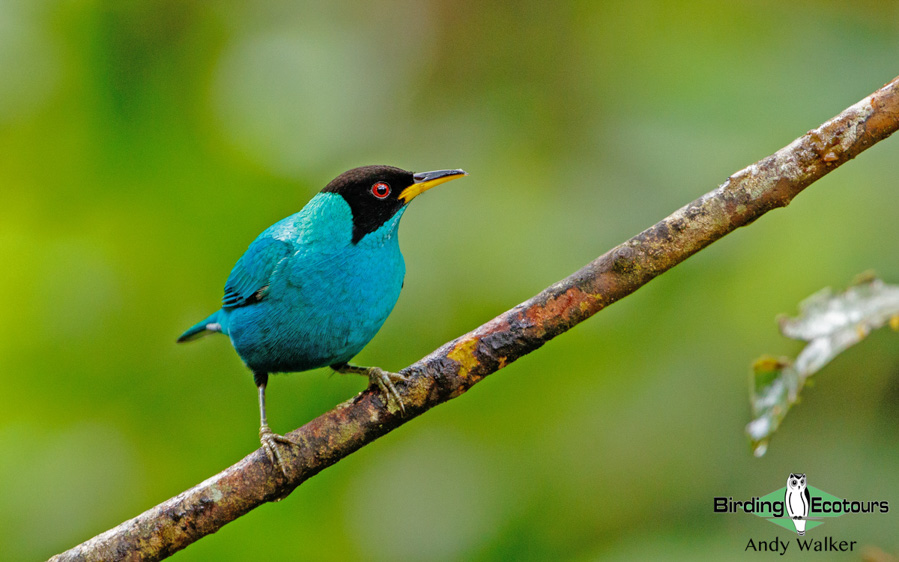
During these seven days, we will look for species such as Green Shrike-Vireo, Brown-hooded Parrot, Blue Cotinga, Slaty-tailed Trogon, Black-throated Trogon, White-tailed Trogon, Gartered Trogon, Black-breasted Puffbird, White-whiskered Puffbird, Collared Aracari, Keel-billed Toucan, Yellow-throated Toucan, Purple-throated Fruitcrow, American Pygmy Kingfisher, Semiplumbeous Hawk, Boat-billed Heron, Song Wren, Black-bellied Wren, Bay Wren, Ocellated Antbird, Spotted Antbird, Dot-winged Antwren, White-flanked Antwren, Scaly-throated Leaftosser, Grey-headed Chachalaca, Crimson-crested Woodpecker, Cinnamon Woodpecker, Southern Mealy Amazon, Blue Dacnis, Green Honeycreeper, Blue-crowned Manakin and Red-legged Honeycreeper. The hummingbird feeders attract species such as White-necked Jacobin, Violet-bellied Hummingbird, Long-billed Hermit and Purple-crowned Fairy.
In addition to birds, Panama offers some of the best chances to see other Neotropical wildlife such as Brown-throated Sloth, Nine-banded Armadillo, White-nosed Coati, Central American Agouti, Geoffroy’s Tamarin and Mantled Howler Monkey.
Itinerary (7 days/6 nights)
Day 1. Arrival and transfer to Canopy Tower Lodge
You will arrive in Panama City, meet our Birding Ecotours tour leader and be transferred to the famous Canopy Tower Lodge. We will spend the afternoon enjoying the lodge surroundings and, if time permits, the Summit Ponds, looking for species such as the elusive White-throated Crake, Boat-billed Heron, Wattled Jacana, Rufescent Tiger Heron and Purple Gallinule. Other birds include Lemon-rumped Tanager, Palm Tanager, Crimson-backed Tanager and Black-striped Sparrow. We might also have our first mammal encounters here with Lesser Capybara and Brown-throated Sloth.
Overnight: Canopy Tower Lodge, where we stay for the entire week
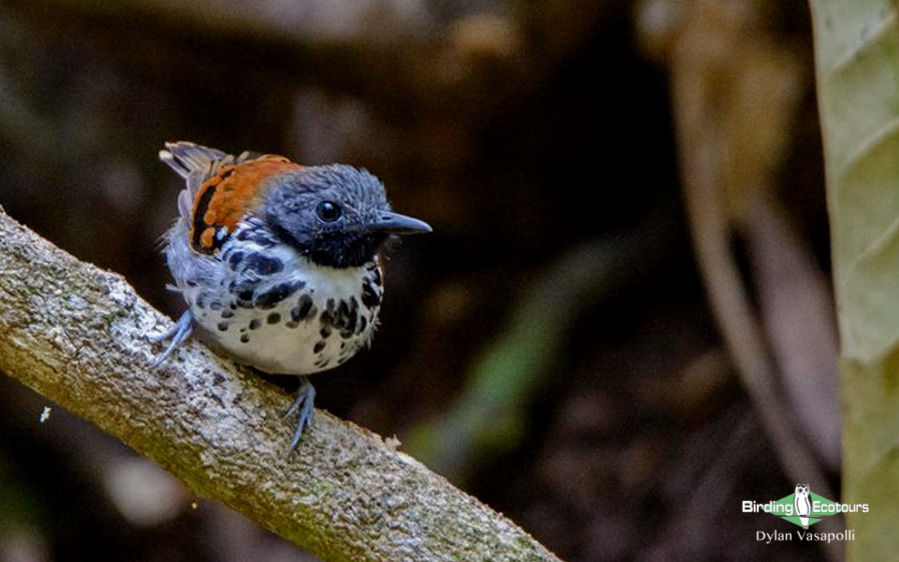
Day 2. Canopy Tower, Semaphore Hill and Summit Ponds
We will meet at the observation deck before dawn and while enjoying some coffee we will listen out for the early calls of Barred and Slaty-backed Forest Falcons emanating from the forest canopy, and will also try to detect the secretive Green Shrike-Vireo and the beautiful Blue Cotinga. Other birds include Southern Mealy and Red-lored Amazons, Brown-capped Tyrannulet, Collared Aracari and the striking Keel-billed Toucan. After breakfast, we will bird the famous Semaphore Hill, looking for Rufous and Broad-billed Motmots, Slaty-tailed Trogon, Semiplumbeous Hawk, Plain-colored and White-shouldered Tanagers, Fulvous-vented Euphonia and Green Honeycreeper. Before lunch, we will check the hummingbird feeders around the lodge entrance, hopefully enjoying views of Blue-chested Hummingbird, Violet-bellied Hummingbird, White-necked Jacobin and Snowy-bellied Hummingbird.
Overnight: Canopy Tower Lodge
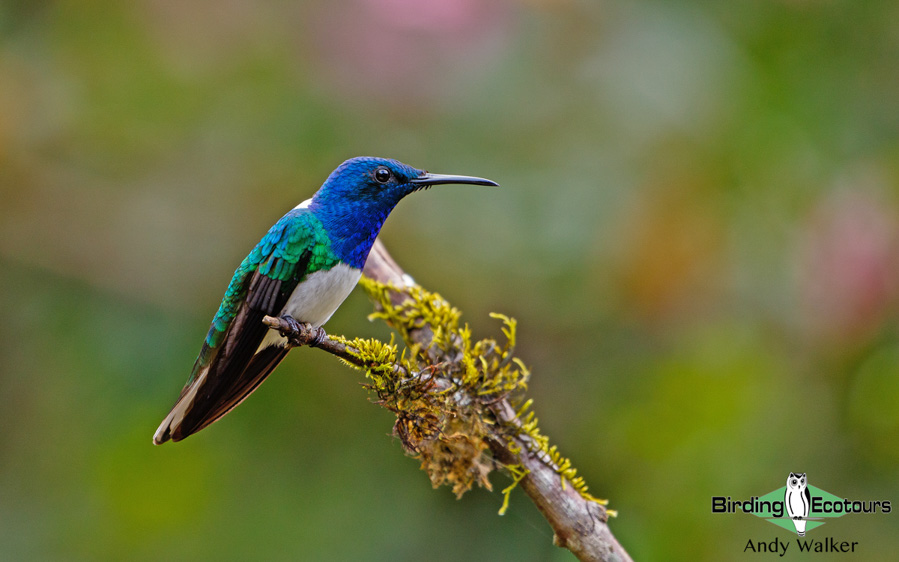
Day 3. Discovery Tower and Pipeline Road
We will have a full day on the famous Pipeline Road, enjoying the incredible avian diversity as we add to our ever-growing list. Target birds include species like Black-breasted Puffbird, White-tailed, Gartered and Black-throated Trogons, Song Wren, Golden-collared Manakin, Purple-throated Fruitcrow, Great Jacamar as well as Fasciated and Black-crowned Antshrikes. If we are lucky to find any army ant swarms, we might see the striking Ocellated Antbird and also Spotted and Bicolored Antbirds, with Northern Barred and Plain-brown Woodcreepers hopefully in attendance too. We will visit some hummingbird feeders and perhaps be entertained by species such as Long-billed and Stripe-throated Hermits, Crowned Woodnymph and if we are lucky Rufous-crested Coquette.
Overnight: Canopy Tower Lodge
Day 4. Pipeline Road and Canopy Tower Lodge
We will spend a full morning exploring the Pipeline Road in search of any species we may have missed during our previous day. We will have a relaxed, non-driving afternoon, enjoying birds close to the lodge from the observation deck or hummingbird feeders.
Overnight. Canopy Tower Lodge
Day 5 – 6. Achiote Road and Canopy Tower Lodge
We shall spend two full mornings exploring the famous Achiote Road looking for species such as Slaty-tailed, White-tailed, Gartered and Black-throated Trogon, Collared Aracari, Black-breasted Puffbird, Keel-billed Toucan, Yellow-throated Toucan, Black-cheeked Woodpecker, Cinnamon Woodpecker, Black-striped Woodcreeper, Spot-crowned Barbet, Red-capped Manakin, Golden-collared Manakin, Purple-throated Fruitcrow, Chestnut-backed Antbird, Spotted Antbird, Dot-winged Antwren, Southern Bentbill, Fasciated Antshrike, Jet Antbird, Black-bellied and Bay Wrens, Blue Cotinga, White-whiskered Puffbird, Rufous Motmot and Brown-hooded Parrot. The afternoons will entail some relaxed birding around the lodge, from the observation deck or around Summit Ponds.
Overnight. Canopy Tower Lodge
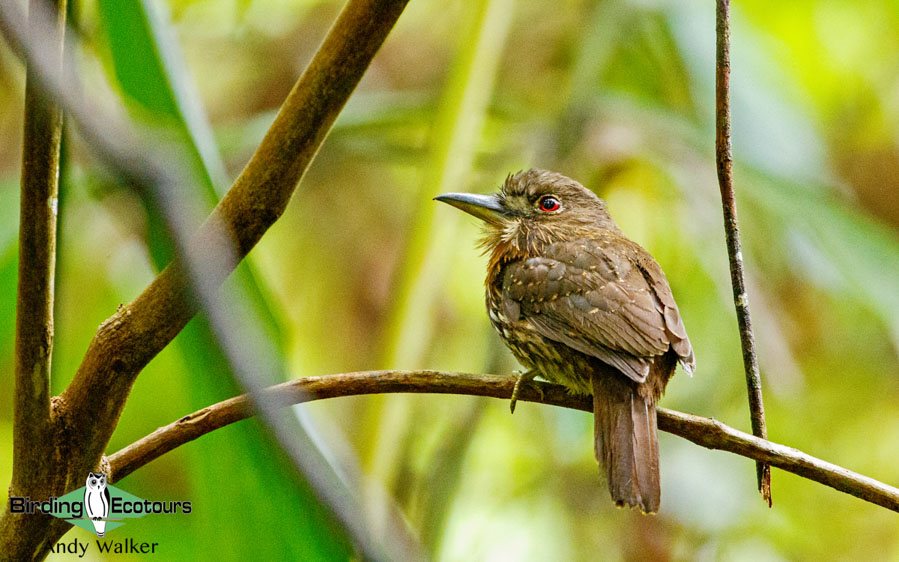
Day 7. Transfer to the airport to connect with international flight
Today we will leave the Canopy Tower Lodge for Panama City’s Tocumen International Airport, from where you can catch your connecting flights back home.
Please note that the itinerary cannot be guaranteed as it is only a rough guide and can be changed (usually slightly) due to factors such as availability of accommodation, updated information on the state of accommodation, roads, or birding sites, the discretion of the guides and other factors.
Download ItineraryPanama: Canopy Tower, Darien, Canopy Lodge and Tranquilo Bay Trip Report
7 – 20 JANUARY 2016
By Eduardo Ormaeche
DOWNLOAD TRIP REPORT
Overview
Birding Ecotours had the opportunity to return to Panama this year as part of a scouting trip to visit the Canopy Family lodges with the main idea to create a tour which can mix the three main accommodation facilities they have. The famous Canopy Tower was built in 1965 by the US Air Force to house powerful radar used in the defense of the Panama Canal. The tower played this role until 1995 and in 1999 was converted into a lodge for ecotourism and birdwatching. With its 360° view from the top of the tower the views of the Soberanía National Park are truly outstanding. Guests are able to visit the tower at dawn before breakfast and are enchanted by the calls of Slaty-backed and Collared Forest Falcons and views of Brown-hooded Parrot, Red-lored Amazon, Blue-headed Parrot, Green Honeycreeper, Plain-colored Tanager, Red-legged Honeycreeper, and with luck and persistence even the elusive Green Shrike-Vireo. We used the lodge as a base for a total of three nights, which allowed us to explore all its surroundings, including famous birding spots like the Pipeline Road and Summit Ponds.
The second place we visited was the new and recently inaugurated Canopy Camp in the Darien Province near the border with Colombia. The Darien conjures up the remoteness of Panama, visions of Harpy Eagles and near-endemic species found only in this part of the country and adjacent Colombia, but, with the latter country still having social and drug problems near the border, birders are not able to visit the Darien in Colombia. Fortunately, Colombia is changing every year and we don’t have any doubt that the Darien will be open for tourist again in Colombia, where a few species still are waiting to be described, as ornithological expeditions have not been conducted there in at least two decades.
The Canopy Family have built a luxurious camp, African safari style, in the Panamanian Darien, which provides all mod cons for birders. You have your own tent or sharing twin bed tents with wooden floors, electricity, two-meter-high ceilings, fans, and private bathrooms with hot showers outside the tent. Like in all lodges they prepare all meals for you and organize drives and hikes around the area.
Canopy Camp is located in a small, private reserve, whose forests hold exquisite species like Black-crowned Antpitta, White-eared Conebill, Double-banded Greytail, and Black Oropendola, among others. Note that Canopy Camp is outside the Darien National Park near Cana. We know that birders had the chance to fly to Cana in the past and hike the famous Pirre Mountain in search of Panamanian endemics, but today the airstrip in Cana has been abandoned, and there are no logistics at all. We spent three nights and four days in the Darien, using the camp as our base to explore the surroundings. We were happy with Canopy Camp, and we think that many of our clients will love it.
The last lodge we visited was Canopy Lodge, located in Anton Valley. Unfortunately, we didn’t have much time to explore this area, but the lodge has excellent access to some mid-elevation species like Black-and-yellow Tanager and Blue-throated Toucanet. The lodge is very comfortable with nice rooms and beautiful views of the woods. They provide all-inclusive service, and even though you have to drive out of the lodge to access most of the key birds, the grounds proper hold species such as Rufous Motmot, Uniform Crake, Bay-headed Tanager, Rufous-capped Warbler, Buff-rumped Warbler, and Sunbittern with some luck (which we had not). The Canopy Adventure (for those intrepid people who want to venture into the top of the trees) provides so far the best opportunity for Rufous-vented Ground Cuckoo.
Our time in the Canopy Family lodges ended, and we took a flight to the Bocas del Toro Province in the northeast of the country. Our next task was to investigate a new place called Tranquilo Bay Eco Adventure Lodge, which is supposed to hold a large list of birds and whose owner, Jim Kimball, had generously been inviting us for the last two years. We didn’t have much information, only that the place was located on Bastimentos Island in the Bocas del Toro archipelago and could harbor birds of the Caribbean rainforest and mangrove specialists.
I have to admit that the place and the attention from the host surpassed my expectations. Birding in Tranquilo Bay Eco Adventure Lodge was paradise. The place is located in the extreme eastern corner of Bastimentos Island with literally nobody around; it is far away from crowds and tourists. The shores of the Caribbean are surrounded by mangroves and Caribbean rainforest. The lodge possesses six comfortable, luxurious cabins with air-conditioning, fans, and spacious private bathrooms including hot showers. The cabins are found in the garden, surrounded by plenty of flowering bushes, which attract several hummingbird species. Some of the cabins face the ocean near the 30-meter-high tower, which allows fantastic view of the archipelago and of birds such as Blue-headed Parrot, Red-lored Amazon, and Double-toothed Kite. The service was first class, with excellent food, complementary drinks, and a lot of fun from our host Jay Viola – for sure some of the best attention we have received in Latin America. We stayed three nights at the lodge and used it as our base to explore the surroundings, which include the main canal in the archipelago, where good birds can be seen, such as Nicaraguan Seed Finch and Three-wattled Bellbird. Probably one of the highlights of the place is the chance to visit Bird Island (Swan’s Cay), where Red-billed Tropicbird roosts throughout the year and flies at eye level, allowing fantastic views that are only comparable with the ones in the Galapagos Islands.
Tranquilo Bay Eco Adventure Lodge can be used as base to explore the low- and mid-elevation Bocas del Toro foothills, allowing birds such as Prong-billed Barbet, Spangle-cheeked Tanager, Boat-billed Heron, Emerald and Speckled Tanagers, and with luck Ornate Hawk-Eagle. The lodge grounds themselves hold bird species like Chestnut-backed Antbird, White-flanked Antwren, Bronzy Hermit, Band-tailed Barbthroat, Montezuma Oropendola, and White-collared and Golden-collared Manakins and provide also the chance to see a few species of hummingbirds taking a bath in a forest stream.
After three nights at Tranquilo Bay Eco Adventure Lodge we had to say farewell to Panama, with the hope to come back with you, our clients and friends, in the near future.
Detailed Itinerary
Day 1, January 7
Arrival in Panama City. Transfer to the Radisson Summit Hotel & Golf. Birding the hotel grounds and surroundings. Overnight Radisson Summit Hotel & Golf.
Day 2, January 8
Transfer to the Canopy Tower. Birding the Canopy Tower and the Gamboa Rainforest Resort and its marina. Overnight Canopy Tower.
Day 3, January 9
Birding the Pipeline Road and the Panama Rainforest Discovery Center tower in the morning and the Summit Ponds in the afternoon. Overnight Canopy Tower
Day 4, January 10
Birding Semaphore Hill and the Plantations Road in the morning and once more the Gamboa Rainforest Resort marina in the afternoon. Overnight Canopy Tower.
Day 5, January 11
Transfer to the Canopy Camp in the Darien Province. Birding El Salto Road. Overnight Canopy Camp.
Day 6, January 12
Birding Quebrada Felix in the morning and the Great Potoo site in the afternoon. Overnight Canopy Camp.
Day 7, January 13
Birding the Darien and exploring the Yavitza area in the morning. Birding around Canopy Camp in the afternoon. Overnight Canopy Camp.
Day 8, January 14
Birding San Francisco Reserve in the morning and transfer to Anton Valley. Overnight Canopy Lodge.
Day 9, January 15
Birding Las Minas Road in the morning and the road to Altos del Maria in the afternoon. Overnight Canopy Lodge.
Day 10, January 16
Last morning birding around Canopy Lodge. Transfer to Panama City. Overnight Radisson Summit Hotel & Golf.
Day 11, January 17
Flight to Isla Colón in the Bocas del Toro Province. Transfer to Tranquilo Bay on Bastimentos Island. Overnight Tranquilo Bay Eco Adventure Lodge.
Day 12, January 18
Birding the channels around the lodge and Bird Island. Overnight Tranquilo Bay Eco Adventure Lodge.
Day 13, January 19
Birding at low and mid elevations on the continental road between Bocas del Toro and David. Overnight Tranquilo Bay Eco Adventure Lodge.
Day 14, January 20
Last morning birding the lodge area. Transfer to Isla Colón and flight back to Panama to connect with the international flight.
Day 1
Dylan Vasapolli and I met at the Tocumen International Airport in Panama City and transferred to the Radisson Summit Hotel & Golf. This was the pre-day of the tour, so we decided to organize ourselves, have lunch, and share our enthusiasm for the upcoming days. The hotel was more than adequate and comfortable.
And, even better, the hotel owns a large extension of natural woodland that has access to good forest, and of course we could not wait and decided to explore it. We followed the main trail after the golf pitch, and it didn’t take much time to find a nice Rufous-breasted Wren, followed by a small mixed flock with male and female White-flanked Antwren, Dot-winged Antwren, Black-crowned Antshrike, and a striking Spotted Antbird. Other common suspects included Blue-grey Tanager, Squirrel Cuckoo, White-tipped Dove, and Whooping Motmot. We also had nice views of nine-banded armadillo and white-nosed coati.
Day 2
After a quick breakfast at the hotel we went back to the woods, finding Long-billed Gnatwren, Orange-chinned Parakeet, Purple-throated Fruitcrow, White-bellied Antbird, and Red-crowned Woodpecker.
Then we were collected by the Canopy Tower shuttle and transferred to the famous Canopy Tower in the heart of Soberanía National Park. After being welcomed by the host and check-in we spent the rest of the morning watching hummingbirds at the feeders, with species like Blue-chested Hummingbird, White-necked Jacobin, Long-billed Hermit, Black-throated Mango, White-vented Plumeleteer, and Violet-bellied Hummingbird.
Then we went to the top of the tower, where the view is amazing at any angle, but it was already warm and there was no activity except for the call of the elusive Green Shrike-Vireo, “can’t see me”.
In the afternoon we visited the marina of the Gamboa Rainforest Resort area near the Chagres River, one of the most important tributaries of the Panama Canal. Here we got bird species such as Great and Lesser Kiskadee, Rusty-margined Flycatcher, Golden-hooded Tanager, Blue-grey Tanager, Palm Tanager, Crimson-backed Tanager, and Plain-colored Tanager. Several Variable Seedeaters were among the reeds, as well as Southern Rough-winged Swallows, Mangrove Swallows, and Black Vultures. We then returned to the lodge for our first checklist session and dinner.
Day 3
We had high expectations for the famous Pipeline Road as probably one of the most productive bird spots in Latin America. But we first visited the new Discovery Center tower inside the Soberanía National Park. It was hot already early in the morning. We found Pale-vented Pigeon, Blue-headed Parrot, Northern Mealy Amazon, Red-lored Amazon, Double-toothed Kite, Green Honeycreeper, Red-legged Honeycreeper, Keel-billed and Yellow-throated Toucans, and the most-wanted Blue Dacnis, and even though the latter was far away, our spotting scopes did the trick.
We descend from the tower and started to bird the road in hope to find juicy army ant swarms. Sadly, we could not encounter any during the whole morning, so our dream of Ocellated Antbird was seriously denied us. Our consolation prize was a party of at least eight noisy Song Wrens at the side of the road. We were also lucky with the trogons, including species like Gartered, Slaty-tailed, and White-tailed Trogons. They were followed by crippling views of Black-breasted Puffbird, Rufous-tailed Jacamar, Lineated Woodpecker, Cocoa Woodcreeper, Yellow-crowned Tyrannulet, Black-bellied Wren, Checker-throated Antwren, Southern Bentbill, a juvenile Rufescent Tiger Heron crossing the road in front of everybody, Dusky Antbird (which was heard only), and some others.
We returned to Canopy Tower for lunch and waited for our afternoon activity, which consisted in exploring the Summit Ponds, where the main target was a daytime roosting colony of Boat-billed Heron, and fortunately we got good views of those and also of Lemon-rumped Tanager, Crimson-backed Tanager, Golden-fronted Greenlet, Tropical Gnatcatcher, Clay-colored Thrush, Tropical Mockingbird, and nice views of Prothonotary Warbler. We heard White-throated Crake but didn’t have any luck with visuals of this secretive species. We also enjoyed Purple Gallinule, Wattled Jacana, and Southern Lapwing, as well as a group of lesser capybara. Then we returned to the lodge for another overnight.
Day 4
A predawn start atop the Canopy Tower allowed us fantastic views of Brown-hooded Parrot and Blue Cotinga. We heard Collared and Slaty-backed Forest Falcons, but unfortunately no cigar on them.
After breakfast we focused on the Semaphore Hill road, which is the road leading to the lodge. We drove the road and made selected stops at several sites. Probably the best bird was a perched Semiplumbeous Hawk, which posed nicely for everybody. We also got several North American warblers, like Bay-breasted Warbler, Chestnut-sided and Tennessee Warblers, in addition to Panamanian Flycatcher, Common Tody-Flycatcher, and many others.
Then we investigated the Plantation Road, where we found Rufous and Broad-billed Motmots and a nice Golden-crowned Spadebill as well as our second Spotted Antbird. An American Pygmy Kingfisher was seen near a stream.
In the afternoon we were asked to make another visit to the Gamboa Rainforest Resort’s marina to photograph the usual suspects there.
Day 5
Today we left the lodge by 5.30 a.m. toward Canopy Camp in the Darien Province. Unfortunately, we could not stop on the road and not visit the Nusagandi Reserve either, which seems to be one of the best places for the most-wanted Sapayoa. It took us over four hours to reach Canopy Camp.
As soon as we arrived we had splendid views of White Hawks soaring above the lodge clearing, and the fruiting trees where full of Chestnut-headed Oropendolas. However, the feeders were not active because of the heat, but even so we managed to find Scaly-breasted Hummingbird and Sapphire-throated Hummingbird.
After lunch and some rest we went for our official first Darien excursion. After a 25-minute drive we reached El Salto Road, where we saw Little Tinamou crossing the road, followed by White-necked Puffbird, Buff-breasted Wren, Grey-headed Chachalaca, Mistletoe Tyrannulet, Western Sirystes, Cinnamon Becard, Plain-colored Tanager, and Blue Dacnis. Before we returned to the camp we scored with the diminutive Pied Puffbird.
After dinner we spotted Pauraque around the campsite, but no other species of nightjars. We managed to hear Mottled and Black-and-white Owls calling very late at night not far from the camp.
Day 6
Today we drove to the entrance of Quebrada Felix. We reached a small parking lot surrounded with secondary growth. Here we got great views of White-eared Conebill and Double-banded Greytail, both targets in the Darien area. We started to walk through the quebrada, passing through both secondary and primary forest. After crossing several streams we reached the habitat of Black-crowned Antpitta. It took us some time, but we were rewarded with magnificent views of this localized and highly-prized species. The antpitta was followed by the striking Bare-crowned Antbird, Black-striped and Plain-brown Woodcreepers, Rufous Piha, Speckled Mourner, White-winged Becard, Golden-headed Manakin, Streaked Flycatcher, Grey Elaenia, and Olivaceous Flatbill. We also flushed Great Tinamou and Mottled Owl along the forest trail. Happy we returned to the camp to celebrate.
In the afternoon we explored some open fields, where we found a day-roosting Great Potoo in the shade. Other species included Red-breasted Blackbird, Streaked Flycatcher, and Blue Ground Dove. At Canopy Camp we then enjoyed dinner and a few cold ones.
Day 7
We decided to start at 4.45 a.m. to track down a pair of Mottled Owls and Common Potoo calling near the campsite. We had walked down the first 25 meters of Nando’s trail when Dylan and I realized that there was a fer-de-lance just at few centimeters from my foot. I managed to move my whole body just in time, and the snake of course tried to run away from us, but we still managed good views of its intriguing pattern, including even the pit sensors below the nostrils.
After breakfast we continued exploring the Darien, finding Bicolored Wren, which is a new record for Panama; this species is commonly found during our Santa Marta tours in Colombia. We also had a brief view of White-headed Wren, Pearl Kite, and Barred Puffbird. Trying for the Great Green Macaw, it was heard but not seen. We drove all the way south of the Darien until we reached Yavitza, which is just a village at the end of the Pan-American Highway, and not far from there we found a nesting tree of the localized Black Oropendola.
We returned to Canopy Camp and decided to bird some fields near the campsite, where we won with Grey-cheeked Nunlet and Black Antshrike. Later around the lodge grounds we found Spot-crowned Barbet, Olivaceous Piculet, and Blue-throated Sapphire.
Day 8
Our last morning in the Darien took us to explore the San Francisco Reserve, located about two hours from Canopy Camp. Here we had more views of White-eared Conebill and perhaps the best view of Blue Cotinga. We tried for Stripe-cheeked Woodpecker, but despite concerted efforts we could not find it. Other species we encountered were Cinnamon Woodpecker, Pale-billed Woodpecker, Crimson-crested Woodpecker, Laughing Falcon, Black-headed Tody-Flycatcher, and Forest Elaenia
At a restaurant in a village called Torti we had lunch while watching some hummingbird feeders with Snowy-bellied Hummingbird among others.
In the afternoon we transferred back to Panama City, where two members of the group had to leave, and then continued to the Canopy Lodge in Anton Valley.
Day 9
After an early breakfast we were transferred to Las Minas, which is a mid-elevation place around the lodge. We stopped the car at one side of the main road and explored a trail, which proved very productive with several good species such as Black-striped Sparrow, White-ruffed Manakin, Red-faced Spinetail, Bay-headed Tanager, Rufous-capped Warbler, Black-faced Antthrush, and White-tipped Sicklebill, among many others.
Then we went to the Canopy Adventure, which is a place run by the Canopy Family to allow clients to visit the treetops, using safe, modern techniques. We had been told that the mythical and legendary Rufous-vented Ground Cuckoo had been seen there daily during the last four days, so of course we had to try. When we reached the location where the cuckoo had been seen on the previous days, though, there was not a trace of any army ants, which the cuckoo searches out because it feeds on insects, scorpions, centipedes, etc., fleeing from the ants. So we decided to stop for a few minutes, which now as I write this seem to be ages, when suddenly the ants appeared – and just like a shadow behind them there it was, Rufous-vented Ground Cuckoo!
We managed to have excellent views of the cuckoo at ten meters from us on the trail and to watch its behavior: feeding, running into the bush, and coming back. Its movements can change from slow to incredible fast and seem to be choreographic. Suddenly the ants started to come towards us, crossing the trail, and even though the cuckoo knew we were there in the middle of the path, it came into the open and started to feed; in a way it seemed unaware of us. We had sunshine on the path and the cuckoo at four meters distance, enabling us to see its shiny colors on the flanks that, I believe, are rarely seen when you only have the bird on a dark forest trail for a quick view. The big surprise was when from behind a huge dead tree two other cuckoos joined the party; at that moment we were both thrilled and shocked, incapable to believe what our eyes were seeing. We could note that one of the individuals was a young one, because the feathers didn’t look as fabulous as those of the other two. Our guess is that it was a family, a pair with a young one, and perhaps that might have been one of the reasons why they had remained in the same area during the last few days. I doubt I could have better views of this bird, ever!
Very excited we went back to the lodge to have lunch and get ready for the afternoon. The afternoon plan was exploring the road that goes to Altos del Maria, but we could not get into the place itself. We tried to find Snowcap, which had been recorded along this road before, but so far to no avail. The activity was slow, but we had great views of Blue-throated Toucanet, Ochraceus Wren, a brief view of Tiny Hawk, Black-and-yellow Tanager, and almost at the end of the day finally a female Snowcap. Then we returned to the lodge for dinner and overnight.
Day 10
We were told that we would be transferred back to Panama City at 9.00 a.m., so after an early breakfast we explored the surroundings of the lodge for a last time. It was very windy, but we managed to find Grey-headed Chachalaca on the feeders, Clay-colored Thrush, and Buff-rumped Warbler along the stream. We looked for Sunbittern without luck, but we were absolutely thrilled by Uniform Crake, which came out into the open but only to quickly disappear again into the thick marsh vegetation near the pool. We also saw Grey-necked Wood Rail in the vicinity.
At 9.00 a.m. we said goodbye to the lodge and drove back to Panama City, where we stayed again at the Radisson Summit Hotel & Golf. We would have had time enough to go to the Metropolitan Park in the city, which is supposed to be the largest and most impressive park in Latin America and home to quite a few juicy birds, but we decided to rather discuss our impressions of the last ten days and ponder what kind of birding itinerary we could develop from the experience for the company. We packed to get everything ready for an international flight and tried to rest a bit and to get some meals and some cold ones as well. Dylan was flying to the United States the next morning to participate in the Space Coast Birding and Wildlife Festival, and I was flying to Bocas del Toro in the north of the country on the Caribbean coast to explore the new Tranquilo Bay Eco Adventure Lodge for three days.
Day 11
We had to start around 3.30 a.m. in order to be on time at the airport for Dylan’s international flight connection. My flight took less than one hour, after which I arrived on Isla Colón, the main island of the archipelago, at the international airport of Bocas del Toro. Here I was met by Jay Viola, one of the owners of the lodge, who was waiting for me and for another visitor who was scouting the lodge as well. Together with Jay were Ramón and Natalia, the resident naturalist guides of the lodge, both biologists with years of experience working with sea turtles. After a five-minute drive from the airport we were at the dock, from where we took the boat to Tranquilo Bay Eco Adventure Lodge. We left town and watched the different small islands of the archipelago pass by. We were heading to the most eastern part of Bastimentos Island, a 21st-century version of “Fantasy Island”, where there is nothing but nature, beautiful sea, birds, wildlife, and peace and silence. On the way to the island we saw Laughing Gull and Common Black Hawk, and Ramón didn’t need much time to prove himself a great spotter, finding Snowy Cotinga for us. There are a few different species of mangroves in the area.
We had a delicious breakfast with Jay, Ramón, and Natalia joining us, who told us the history of the lodge and the area. They then showed us around the lodge, and we were very impressed not only with its quality but particularly with the massive amount of work they had done to develop every single detail exactly as they wanted it. It was very hot, so after seeing the grounds we planned a hike for the afternoon. I watched the flowering bushes looking for hummingbirds, but I could not get much except a rather aggressive Rufous-tailed Hummingbird.
In the afternoon Ramón and Natalia took us along one of the trails, where we got Stub-tailed Spadebill. This bird just sneaks into Panama and is only found in his area at the most southern part of its distribution. We also found Passerini’s Tanager and Yellow-crowned Euphonia, and a secretive Mourning Warbler was seen well, skulking in the vegetation. A flock with White-collared and Variable Seedeaters was studied well with the hope to find Thick-billed Seed-Finch. We heard White-throated Crake, but not cigar again. At a stream in the forest we watched a nice male Red-capped Manakin and Crowned Woodnymph taking a bath.
Day 12
After an early breakfast we left the lodge to spend a full day exploring some channels among the mangroves and the coastline near the lodge. We entered the first channel, and sitting on the floating vegetation was our first target of the day, Thick-billed Seed-Finch, followed soon by Baltimore and Orchard Orioles, American Yellow and Prothonotary Warblers, Belted Kingfisher, Green Heron, Western Osprey, Little Blue Heron, Squirrel Cuckoo, and more Passerini’s Tanagers.
More Montezuma Oropendolas were called, and then Ramón again found Nicaraguan Seed Finch, of which we had nice views of male and female in the same spot. We continued sailing along the channel when a very distinctive call made stop, and simultaneously we said “bellbird”, with some excitement turning into desperation before we luckily found a place to park the boat well and actually found some open ground to walk on the island. A few minutes later we were below Three-wattled Bellbird, great! In both Panama and Costa Rica the bellbird and the umbrellabird make local altitudinal migrations, which renders them rather unpredictable.
Once out of the channel we saw a massive flock of ducks with at least 250 individuals, including species such as Lesser Scaup, Blue-winged Teal, American Wigeon, Black-bellied Whistling Duck, and two Masked Ducks. West Indian manatee and Neotropical otter can be seen in this area, but we had no luck. Another nice show was had when we visited a lek of White-collared Manakin, where we saw a few males of the endemic subspecies almirante.
The time was then right to go to Bird Island, and, even though the sea was a bit rough while sailing to the island, we were full of excitement. Soon we were face to face with the gorgeous Red-billed Tropicbird, which actually nests and roosts year-round on this island. Simply beautiful! We saw several Brown Boobies as well.
Very satisfied we returned to the lodge for a celebration. At dusk we saw a crab-eating raccoon and a Central American wooly opossum near the lodge.
Day 13
This was another early start to get back in the boat and sail to the mainland to explore the road that connects the Bocas del Toro and David Provinces. We focused on lowland and mid-elevations. Unfortunately, we were cursed with the weather with a whole day of rain. Our first stop was in the lowlands, were several African buffalo were enjoying the mud. Here we had Red-breasted Blackbird. Then we stopped by a marsh, where we found a few Boat-billed Herons roosting at daytime. Keel-billed Toucan, and Collared Aracari, and Yellow-throated Toucans were seen along the drive despite the rain.
We stopped at mid-elevation and were lucky to get a mixed flock with Emerald Tanager, Speckled Tanager, Black-and-yellow Tanager, Green Honeycreeper, Summer Tanager, Silver-throated Tanager, Mistletoe Tyrannulet, Rufous-browed Tyrannulet, Olivaceous Woodcreeper, and Cinnamon Becard. And just when we thought the rain would stop it got worse, of course. We kept driving to the highest point of the day and found two good species, Spangle-cheeked Tanager and Prong-billed Barbet, among the regular usual suspects. When we returned to the lowlands we found a perched King Vulture and Striped Cuckoo calling from a bush.
We returned to the boat and sailed back to the lodge; on the way we enjoy Royal and Cabot’s Terns as well as a single Parasitic Jaeger.
Day 14
After a nice morning around the gardens, adding Band-tailed Barbthroat and Bronzy Hermit to my personal list, sadly I had to leave this marvelous place on my way back to Isla Colón for the connection with my flight to Panama City. On the way to the island I could enjoy views of a spotted eagle ray. Once in Panama City, I was transferred to Tocumen International Airport for my flight back to Lima.
Please see the downloadable PDF above with the full species lists included. This is a sample trip report. Please email us ([email protected]) for more trip reports from this destination.

